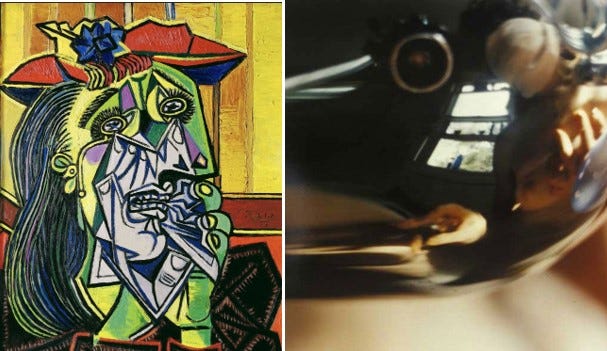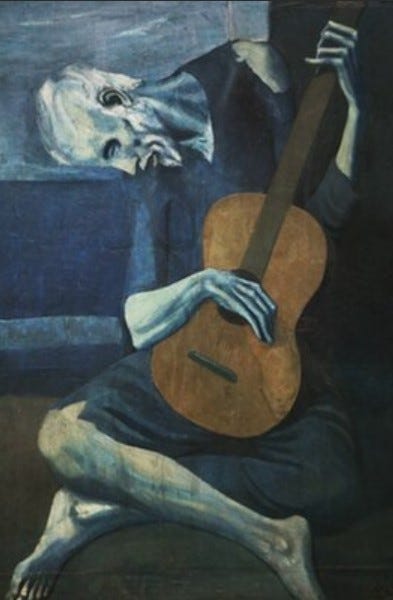Ceasefire from Within
2 Interviews...Reconciling the Personal-Political, Private-Public, Individual-Collective
Picasso’s La Femme qui pleure, 1937 with my self-portrait analog color photograph in San Francisco Museum of Modern Art’s permanent collection, 1994
1980. Paris. I found home the first time I visited Le Musée Picasso. As a nine-year-old overwhelmingly seduced by Picasso’s contorted bodies, the world suddenly made sense. I recognized myself within a Deleuzian vulnerable swarm.
Integrity. Clarity. Exposure.
Picasso’s grotesquely beautiful heads integrated into monstrous forms, helped me feel at ease in my own body—dissonant and rich with life-affirming energy and sensual and political potential. My body-mind straddled the dialectical possibilities: “Understanding, definition, and concept are opposed to ravishment or rapture, to the seizing of consciousness by an ecstatic sensuality that overflows reason in all directions” (Dufourmantelle, Anne. Blind Date: Sex and Philosophy, 69).
Mirroring Hélène Cixous, Georges Bataille’s characters’ “plurality of impulses” (Will to Power Sections 484-485) reminded me of Picasso’s figures. Their “brutal frenzy” and surrender to the “lewd” confirmed who I am, who I have always been. Congruently, Hans Bellmer’s displaced body parts “as materialization of hysterical conversion symptoms” (Dufourmantelle, 18) formed his commitment to mind-body relations. The lush, precise excesses and the fertility of chaos in both Picasso and Bataille spawn an economy of over-abundance, an erotics of the uncanny, digesting the stranger within. I saw this stranger in myself, and this is who I see when I read and re-read Bataille. Similarly, Clarice Lispector and Cixous ask, “Who are you who are so strangely me?” (1991: xiv). “Breaking down walls...leads to the recognition of the stranger even in those one loves, or is” (ibid. xii). “Love your fellow being as if he were your stranger...” (ibid. xvii). Cixous and Lispector lead us right back into the pregnant chiasma of no resolution.
My intention has always been to move beyond the question of who is disfigured by whose power, and challenge how that disfigurement can be re-conceptualized as a vibrant and affirmative collaborative social movement—generating a ceasefire from within.
1903. The Old Guitarist painted during Picasso’s Blue Period—depicting poverty, misery, alienation
The Man With The Blue Guitar
Wallace Stevens
The man bent over his guitar,
A shearsman of sorts. The day was green.
They said, 'You have a blue guitar,
You do not playthings as they are.'
The man replied, 'Things as they are
Are changed upon the blue guitar.'
And they said then, 'But play, you must,
A tune beyond us, yet ourselves,
A tune upon the blue guitar
Of things exactly as they are.'
The following two interviews share fragments of how we can collectively play the blue guitar—transforming the allegedly fixed, inevitable realities, what we take for granted as the norm.
Two Interviews:
1. FearTalk 31: Cara Judea Alhadeff & R. Michael Fisher
and
2. With Kelly Moody
See full image in my Trickster series
I’d love to hear your responses to the interviews! photo@carajudea.com—More recent interviews on their way…Please consider donating!






